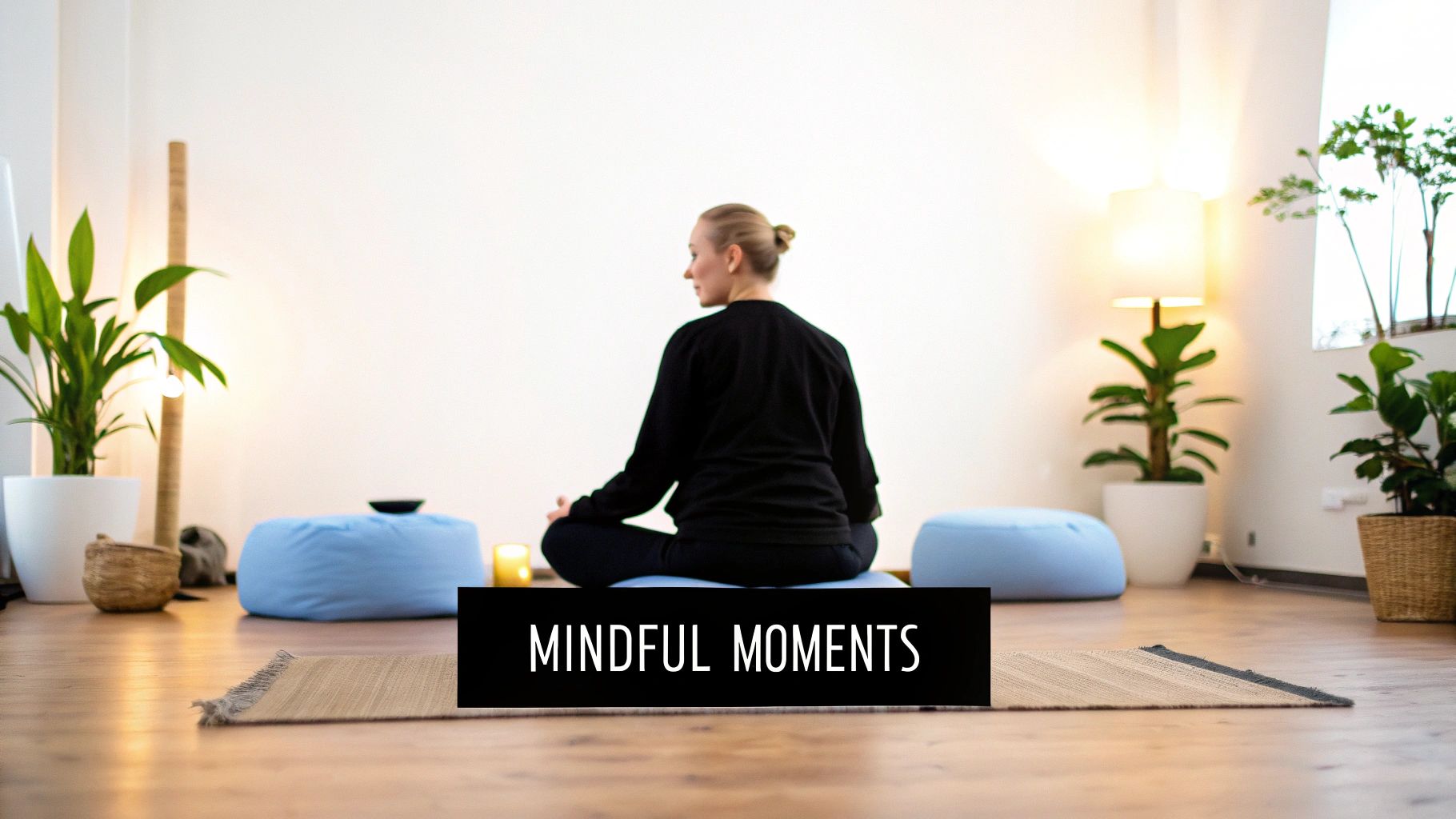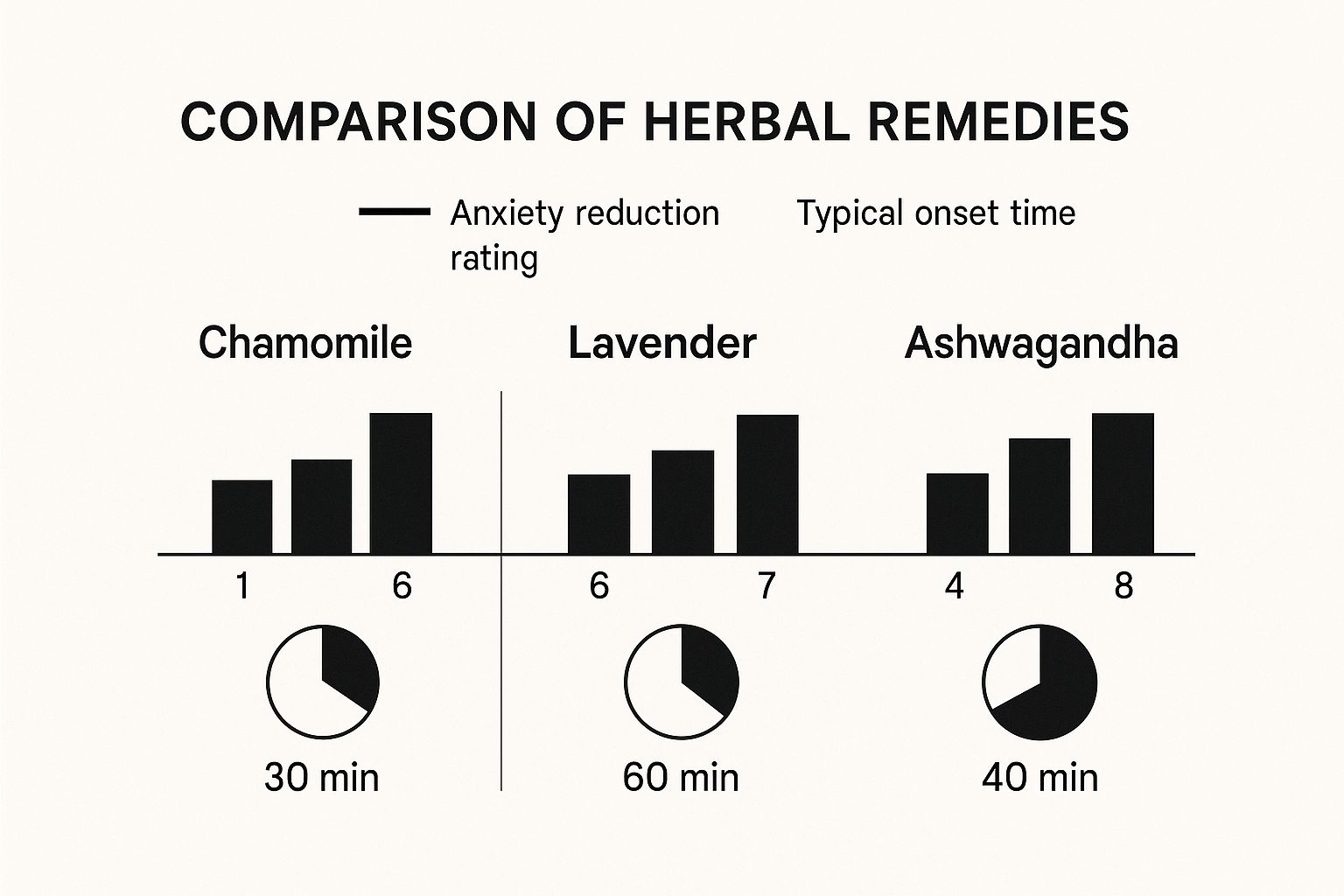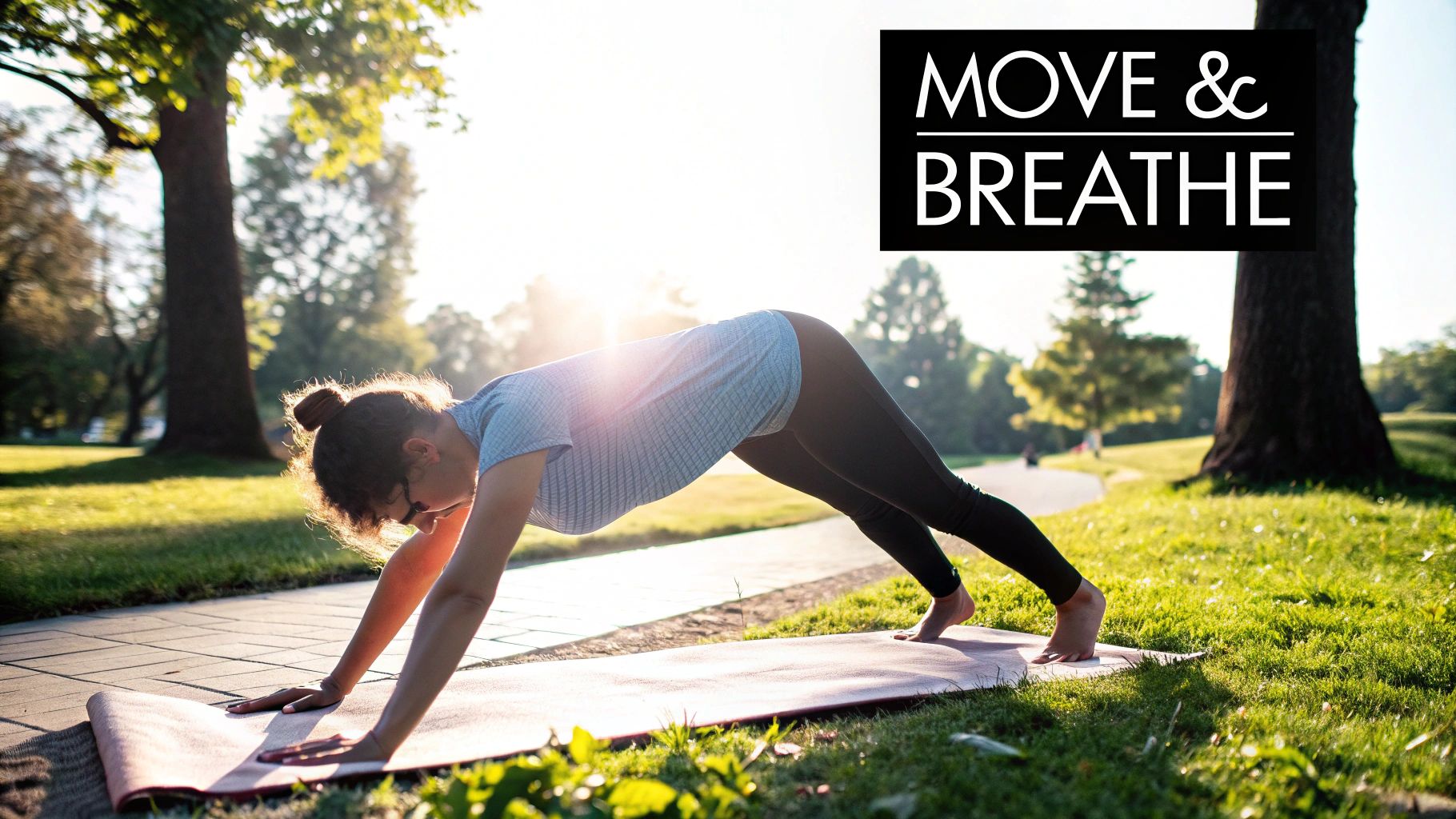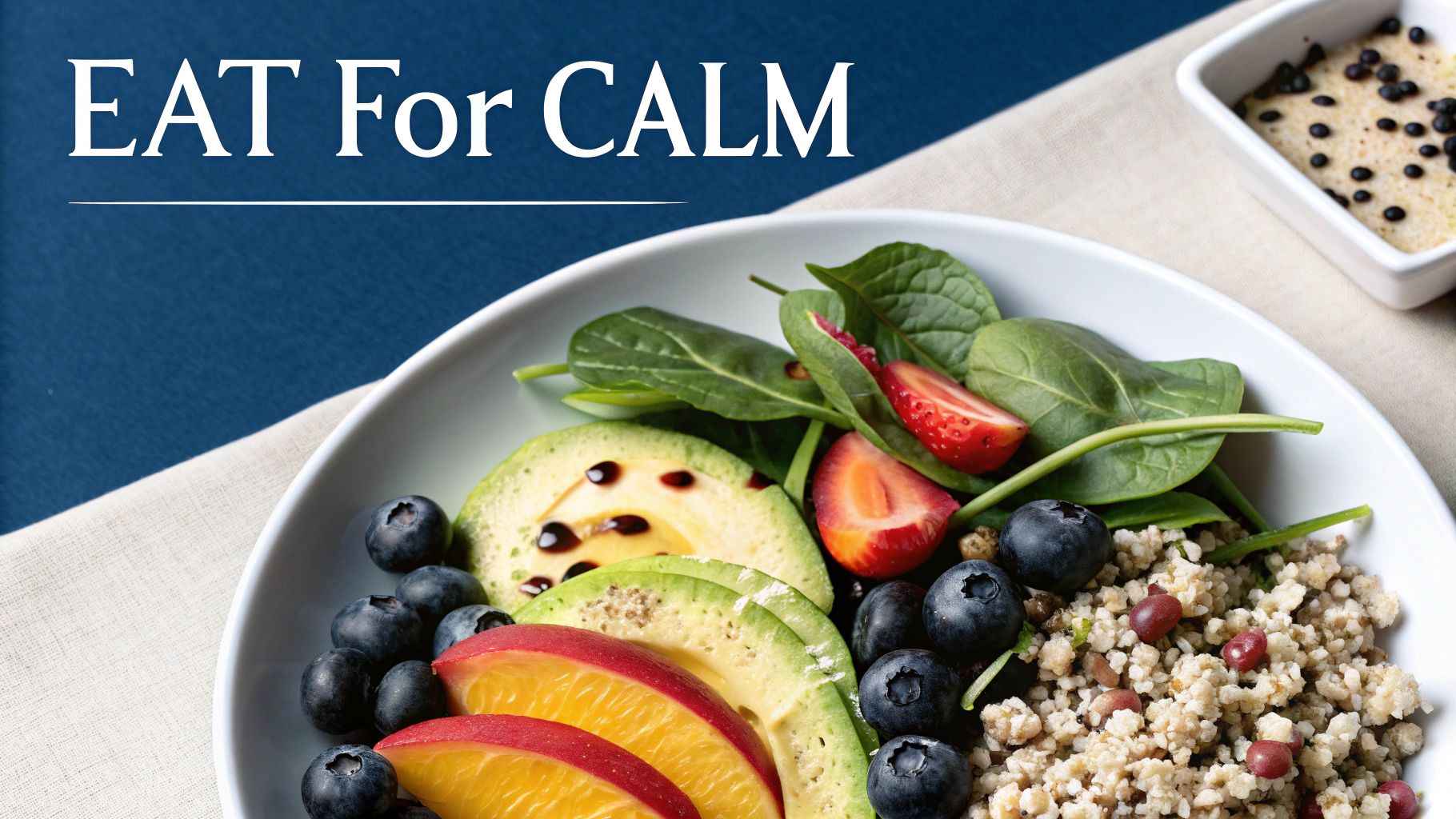That feeling of anxiety creeping in is something we all know. It’s a completely human response, but it absolutely doesn't have to run your life. The best ways to manage it are often the simplest ones—things like tuning into your breath, moving your body gently, and eating well. These aren't just quick fixes; they're powerful tools that help you work with your body’s stress response, not fight against it.
Your Starting Point for Natural Anxiety Relief
If you’re looking for ways to handle anxiety without turning to medication, you've landed in the right spot. So many of us are searching for practical, proven strategies to get back a sense of calm and feel more in control. This isn't about finding one single "cure," but about building a personal toolkit of techniques that actually work when you're feeling overwhelmed.
This guide gets straight to the point, focusing on the core pillars of feeling good, mentally and physically. We’ll skip the generic advice and jump into real, actionable steps you can start using today.
- Mindful Breathing: We'll explore how your breath can be an instant anchor, calming your nervous system in minutes.
- Intentional Movement: You'll discover how the right kind of physical activity can release mood-boosting endorphins and dial down stress hormones.
- Supportive Nutrition: We’ll look at the undeniable link between the food on your plate and the way you feel.
The real goal here is to build resilience by understanding how your body handles stress. By introducing small, consistent habits, you can create massive change over time. A huge part of this journey is learning how to break bad habits that might be feeding your anxiety in the first place.
By focusing on these key areas, you can start being proactive about your mental wellbeing and find a little more calm in the chaos of daily life.
Mastering Your Breath to Calm Your Nervous System
When anxiety spikes, your breath is the fastest, most direct tool you have to get back on solid ground. It’s not just about taking a random deep breath; it’s about using specific techniques to send a powerful signal to your body that it’s safe to relax.
This kind of intentional breathing flips the switch on your parasympathetic nervous system, which acts like a brake on your body's stress response.
By slowing your heart rate and reining in cortisol levels, controlled breathing can stop the physical symptoms of anxiety before they spiral out of control. It’s a simple, powerful act that shifts you out of "fight or flight" and back into a state of calm. Best of all, it's a natural way to reduce anxiety you can use anytime, anywhere.

Simple Techniques for Immediate Relief
Let's walk through a couple of effective methods you can try right now. They're discreet enough to do before a big meeting, during a stressful commute, or even to help you drift off to sleep.
The first is Box Breathing, a technique used by everyone from athletes to emergency responders to stay composed under intense pressure. It’s incredibly straightforward:
- Inhale slowly through your nose for a count of four.
- Hold your breath for a count of four.
- Exhale slowly through your mouth for a count of four.
- Hold again for a count of four before you repeat the cycle.
Another powerful method is the 4-7-8 Technique, which I find is especially brilliant for calming a racing mind before bed. You simply inhale for four seconds, hold for seven, and then exhale slowly and completely for a full eight seconds. That long exhale is the real key to triggering deep relaxation.
Remember, the goal isn't perfection. It’s about giving your mind a single, simple thing to focus on—your breath—which pulls your attention out of anxious thought loops and grounds you in the present moment.
For a deeper dive into these methods and a few others, you can explore our detailed guide on breathing exercises for anxiety that offers step-by-step instructions.
Making these practices a regular part of your day, even for a few minutes, builds incredible resilience. They stop being just emergency measures and become a foundational part of your mental wellbeing toolkit.
The Powerful Link Between Movement and Mood
We all know that physical activity is good for our bodies, but it’s one of the most powerful natural tools we have for managing anxiety. It acts as a direct counterbalance to the body's stress response.
When you get your body moving, it kicks off a fantastic chemical reaction, releasing mood-lifting endorphins while actively lowering stress hormones like cortisol. This isn't about punishing yourself with gruelling gym sessions; it’s about finding a rhythm of movement that feels good and genuinely brings you a bit of joy.
The secret really is consistency, not intensity. A brisk 20-minute walk on your lunch break, a gentle yoga flow in your living room, or even just dancing around the kitchen while dinner cooks can make a world of difference. These moments shift your focus away from the whirring of anxious thoughts and ground you back in your body, offering almost immediate relief.
Finding Your Rhythm
To make movement a sustainable part of your life, the trick is to match the activity to your energy level and what you actually enjoy. What works wonders for one person can feel like a total chore to another.
Think about what you genuinely like doing:
- For a gentle release: Try some simple stretching, tai chi, or a slow, mindful walk in a local park. These are perfect for those days when you feel completely overwhelmed and just need to soothe your nervous system.
- For an energy boost: A brisk walk, a bike ride, or a fun dance class can help you burn off that restless, nervous energy, leaving you feeling more positive and clear-headed.
It’s about finding the right fit for you on any given day. To help you choose the best activity for your needs, here's a quick guide.
Choosing Your Anxiety-Reducing Activity
| Activity Type | Anxiety Benefit | Best For |
|---|---|---|
| Brisk Walking/Jogging | Releases endorphins, reduces cortisol, burns off nervous energy. | Days when you feel restless and need a mental reset. |
| Yoga or Tai Chi | Calms the nervous system, promotes mindfulness, connects breath to movement. | When you feel overwhelmed and need to slow down your thoughts. |
| Dancing | Boosts mood through music and movement, provides a fun distraction. | Times when you need an injection of joy and to shake off stress. |
| Gardening/Yard Work | Grounds you in nature, provides a sense of accomplishment and focus. | When you want gentle, purposeful movement without a formal "workout". |
Each activity offers a unique way to reconnect with your body and find a sense of calm. The best choice is simply the one you'll actually do.
And just as different movements suit different moods, it’s worth remembering that various natural remedies work in unique ways, too.

As you can see, some remedies like Lavender offer a quicker onset, while others like Ashwagandha might provide a stronger overall reduction in anxiety symptoms over time. It’s all about finding what works for your body and your mind.
Small Steps, Big Impact
Here in the UK, the connection between physical activity and mental health is thankfully well-recognised. In fact, NHS reports show that just 30 minutes of brisk walking five times a week can reduce symptoms of anxiety by up to 25%.
This makes movement one of the most accessible and effective tools you can have in your corner. If you're interested, you can discover more about the data behind declining mental health in the UK and see how natural interventions are making a difference.
The goal is to reframe exercise from something you have to do into a moment you take for yourself. Think of it as a form of active meditation that benefits both your mind and body.
By weaving moments of joyful movement into your week, you create a powerful, proactive defence against anxiety, building your resilience one step at a time.
Nourishing Your Nerves Through Mindful Eating

The link between what you eat and how you feel is incredibly strong. You’ve probably heard the gut called our "second brain," and for good reason—it has a direct line to your mood and anxiety levels. Making small, mindful shifts in your diet is one of the most powerful natural ways to manage anxiety for the long haul.
This isn’t about some restrictive, all-or-nothing diet. It’s simply about adding in more of what your nervous system loves. Think of it as nourishing your nerves from the inside out.
Foods That Foster Calm
Certain nutrients are absolute champions at supporting a calm state of mind. By making a point to include them, you’re giving your body the building blocks it needs to handle stress more effectively.
- Omega-3 Fatty Acids: These are vital for brain health and have been shown to help lower anxiety. You’ll find them in oily fish like salmon and mackerel, but also in walnuts and chia seeds.
- Magnesium: Often called nature's relaxant, this mineral helps regulate your body's stress hormone, cortisol. Leafy greens like spinach, almonds, and even dark chocolate are fantastic sources.
- Complex Carbohydrates: Forget the quick-burning sugary carbs. Foods like oats, brown rice, and quinoa provide a slow, steady release of energy that helps keep your blood sugar—and your mood—stable.
A simple swap can make a real difference. Instead of reaching for a sugary biscuit when you feel a dip in energy, try a handful of almonds and a few squares of dark chocolate. You’ll get a sustainable boost without the subsequent crash.
Taming Your Triggers
Just as important as adding the good stuff is noticing what might be making your anxiety worse. Caffeine and sugar are two of the biggest culprits, often causing energy spikes and crashes that can feel eerily similar to the physical symptoms of a panic attack.
That mid-afternoon coffee might feel necessary, but the jitters and disrupted sleep that follow can seriously amplify anxiety. In the same way, a high-sugar snack sends your blood sugar on a rollercoaster, leaving you feeling irritable and on edge once it crashes.
Making these kinds of thoughtful dietary improvements has a proven impact. In fact, a UK study found a 17% reduction in anxiety symptoms when participants improved their diet quality over six months, particularly by upping their omega-3 intake while cutting back on sugar and caffeine. You can learn more about how diet quality impacts mental health and see the full picture.
Remember, the goal is progress, not perfection. Start with one small change, like swapping your morning latte for a green tea, and see how you feel. You can build from there.
So, Why Are Natural Anxiety Approaches Catching On?
It’s not just you. More and more people are looking for natural, practical ways to manage anxiety, and for some very good reasons. Here in the UK, there's a real shift towards proactive, self-managed strategies that you can use to feel better right now.
This isn't just some passing trend. It's a direct response to what's happening in the real world. With NHS mental health services under incredible strain, long waiting lists are often the reality. It's completely understandable that people are searching for accessible tools to look after their own wellbeing now, instead of months down the line.
This drive towards self-empowerment is all about finding holistic solutions that actually fit into your daily life.
The Rise of Proactive Wellbeing
The whole conversation around mental health is changing, and for the better. There's a much bigger focus on prevention and community-based support. One of the most positive developments has been social prescribing, which is when healthcare professionals formally recommend activities that support your mental wellness outside of a doctor's surgery.
These aren't complex treatments. They're often simple, accessible things like:
- Joining a local walking or running group
- Getting involved with a community gardening project
- Enrolling in a mindfulness or meditation course
The goal is to connect you with resources that build resilience and fight the sense of isolation that anxiety can often bring. It’s a recognition that feeling well is built through daily habits and human connection, not just clinical appointments.
By taking these small, consistent steps, you become an active participant in your own mental healthcare. It’s about building a supportive framework that helps you handle stress before it boils over, making you a true partner in your journey to feeling calmer.
The data backs this up. The prevalence of common mental disorders, including anxiety, jumped from 17.6% to 22.6% among adults in England between 2007 and 2024. In response, social prescribing schemes have grown, and the early results are promising—showing that 20-30% of patients see a reduction in symptoms through these kinds of natural interventions. If you're interested in the bigger picture, you can explore the full mental health pressures data analysis for yourself.
Building Your Personal Anxiety Toolkit

Effectively managing anxiety isn’t about finding a single magic bullet. It’s about building a personalised collection of simple, reliable strategies you can turn to whenever you feel that familiar wave of stress begin to rise. Think of it as your own practical, go-to list for life's overwhelming moments.
The goal is to have different tools for different situations. This simple act puts you back in the driver's seat, ready to respond to stress with intention rather than letting it take over. This is one of the most empowering natural ways to reduce anxiety.
Crafting Your Go-To List
Your toolkit should be completely unique to you, reflecting what genuinely helps you feel grounded and calm. It doesn't need to be complicated—a simple list you can keep on your phone or in a notebook is perfect.
Here’s an idea to get you started, thinking about different moments in your day:
- For morning overwhelm: A five-minute box breathing session before you even think about checking your phone.
- For midday stress: A brisk, 15-minute walk outside, focusing entirely on your surroundings. Notice the trees, the sky, the sounds.
- For an afternoon slump: A magnesium-rich snack like a handful of almonds and a square of dark chocolate. Simple, but effective.
- For evening wind-down: A mindful inhalation ritual using a calming aroma to signal to your body that it’s time to rest.
Creating your toolkit is all about being proactive. By having a pre-planned response for common triggers, you massively reduce the mental load of deciding what to do when you're already feeling anxious.
Integrating calming scents can also be a game-changer. To explore this further, check out our guide on using essential oils for relaxation and see how different aromas can support your wellbeing.
Got Questions About Going Natural with Anxiety?
Dipping your toes into natural methods for anxiety always brings up a few questions. It's completely normal to wonder if these things actually work and how long you need to stick with them to feel a real difference. Let's clear up some of the most common ones.
A big one I hear a lot is, "Can these natural techniques really replace my medication?" It's a fair question. For some people dealing with mild to moderate anxiety, a solid routine of better food, regular movement, and consistent mindfulness can absolutely be enough to keep symptoms in check.
But it’s vital to see these as powerful tools in your toolkit, not a direct swap for professional medical advice—especially if you're dealing with a more severe anxiety disorder. Always chat with your doctor before making any changes.
Another common worry is how quickly you'll see results. Unlike medication that can work on a chemical level pretty fast, natural approaches are all about building resilience over time. You might feel a wave of calm right after a good breathing exercise, but the deep, lasting benefits come from making it a habit.
Think of it like getting fit. You don't build muscle after one trip to the gym, do you? But if you keep showing up for a few weeks, you start to feel stronger. It’s the exact same principle here. Small, daily actions build incredible, lasting strength in your mental wellbeing.
Can These Methods Help with Panic Attacks?
Yes, they really can. When you're in the throes of a full-blown panic attack, grounding techniques are your best friend. Controlled breathing, in particular, is a game-changer.
By forcing your focus onto a physical sensation—like the feeling of the air filling your lungs, or your feet planted firmly on the floor—you can yank your mind out of that terrifying spiral of fear. It anchors you back in the present moment, which is exactly where you need to be.
The trick is to practise these skills when you're calm. That way, you're building a reliable toolkit that you can reach for instinctively when you really, truly need it.
For a simple, effective way to get mindful breathing into your day, AuraFlow offers a calming ritual. The gentle, flavourful inhalation gives you an immediate sensory focus, helping you ground yourself anytime, anywhere. Discover the Starter Kit and find your moment of calm at https://aura-flow.co.uk.
